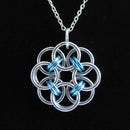Introduction: How to Make a Wooden Folding Knife
Knives are useful tools for many different applications (as Mrballeng has demonstrated), but what if you've got an aspiring boy scout around or you just want to teach someone how to handle knives safely? Or maybe you're like me; you're trying to make a knife of your own design and need to make a prototype first. Well then this is just the thing for you!
The main reason I chose to make my own folder is because most of the nicer ones you find on the market nowadays are over 3" long or are a bit too wide to fit comfortably in "girl pockets" (if you've never experienced them you have no idea how lucky you are). Plus I figured it'd be a nice challenge.
**Note** Please make an effort to read the annotations, I think they're more helpful than the formal instructions.
Step 1: The Design
Now this is where you get creative. You have to keep a few things in mind, but other than that you have free reign here. Just do whatever you want and by the end of it you should have a nice blade and handle shape.
Remember that you need to leave room for standoffs or a backspacer while the blade is in the closed position (see last pic). Also you should put a fair bit of care into figuring out the placement of the pivot and adjusting the blade length accordingly. If the pivot isn't aligned properly you're liable to end up losing a lot of blade and handle width by trying to correct it (or you could turn the misalignment into a "feature").
Step 2: Cutting Out the Scales
Now for the fun part, actually making the prototype!
I used some 1/8" hardboard we had lying around, but anything should do (real wood, acrylic, platinum, unobtanium, etc.). I just traced around the template twice, cut out both pieces with a bandsaw (a coping saw or even a hacksaw would do just as nicely), and held them together while sanding the edges smooth for nice crisp lines.
At the end I took just a bit more out of the choil area on the left scale to help with ergonomics and releasing the lockbar (but that would only apply to the real thing).
Step 3: The Blade
Basically the same as the scales: trace --> cut --> sand --> enjoy!
Step 4: Assembly!
Here's the nerve wracking bit, drilling the pivot hole. Mark the center of the hole (I used a screw, very high tech), then just go for it and hope it works (but you know it works, right? You did all that prepping). After you drill the first hole, line up the two scales and, using the first as a guide, drill through the second. Now for the blade. Position it where you want it to be, then use the first scale as a guide again and drill through.
Now comes the moment of truth. Using a rod or dowel as the pivot, rotate the blade to the closed position and check the fit. In my case, it came out perfectly!
Step 5: The Standoff (nope, Not a Mafia Movie)
Now that the pivot's done, we need to keep the other side from shifting around too much. Enter the standoff! In this case it's just a little piece of scrap that serves as a spacer to prevent the blade from pinching.
Step 6: Whaddya Call a Good-looking Thumb? a Thumbstud! (I Can Hear the Crickets Chirping)
If you're planning on making your folder a one-handed opener, a thumbstud (or other variant such as a thumbdisk or spydie hole) is a must. It's easy enough, just make sure that it'll clear the choil, drill a hole, and glue in a piece of rod. I'd recommend filing or sanding down the top of the stud so you don't chew up your thumb while using it.
Step 7: Stop! Hammer Time! Or, Well, Stop Pin Time. (part 1: the Closed Position)
This is what makes the knife impressive (at least, in my opinion). Once you've got this, you have a fully functioning folder! The only thing it doesn't do is lock in the open position, but we can just call it a friction folder for now, right? Right.
Now this is a bit tricky to explain, so hopefully the pictures will help. You want the stop pin to rest in a semicircular cutout in the blade. Mark the bottom of the blade (when positioned exactly where you want it to be in the end), and mark where the pin will go. I suck at explaining, so please look at the pictures (and feel free to leave comments if it still makes no sense, I don't blame you).
Step 8: Stop! Part 2: the Open Position
Same deal as the last step, but in the open position :)
See annotations for details about what's going on.













